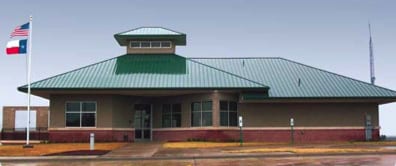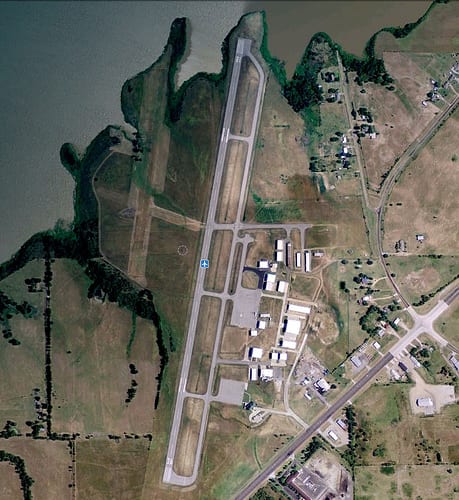Joey Baker says he never met a pilot who didn’t want a seaplane rating. Working off that premise, he’s hoping that Sulphur Springs Municipal Airport (SLR) in Texas will become a destination for seaplane pilots across the United States.
“There’s a big gap in the middle of the United States,” he says he’s been told by seaplane pilots, who note there are plenty of facilities for them in Florida, Louisiana, Alaska, Minnesota, and other states. “But here in the middle of the United States, there’s really not anywhere accommodating for them.”
 He envisions starting small, developing some of the basic infrastructure to accommodate seaplane pilots, such as a ramp and a dock on adjacent Lake Sulphur Springs, connected via taxiway to the existing airport taxiways.
He envisions starting small, developing some of the basic infrastructure to accommodate seaplane pilots, such as a ramp and a dock on adjacent Lake Sulphur Springs, connected via taxiway to the existing airport taxiways.
“We can use that as a way to test the market,” he says.
Developing a seaplane base is part of a recent update to the Airport Layout Plan (ALP), but was not part of the airport’s existing Master Plan, developed in 1999.
Since then, improvements include a new terminal building, additional ramp space, the addition of an AWOS (Automated Weather Observing System), new hangars, and upgrades to the runways.
Those improvements led the Texas Department of Transportation to name SLR “Airport of the Year” in 2003.
Other recent improvements include a runway and taxiway revitalization project, as well as new pilot-controlled runway lights, installation of a Precision Approach Path Indicators (PAPI), and the approval of two new WAAS approaches.
Also in the updated ALP are plans for building additional hangars. But a top priority is resolving some drainage issues the airport is facing.
“Being next to the lake is a blessing and a curse,” Baker admits, noting that the more structures built on the airport, the more drainage problems they have. Airport engineers are working closely with the city’s engineer to eliminate those problems.
Even with the drainage problems, having the 1,400-acre lake next to the airport could develop into a significant economic advantage, he hopes.
Situated between Dallas and Texarkana, Sulphur Springs is in the heart of the East Texas Lake Country. The area has long promoted itself as a premiere fishing destination, according to Baker, who notes that nearby Lake Fork is famous for the size of its large-mouth Bass and quality Crappie fishing.
 There are a number of lakes available to seaplane pilots who could use SLR as a base, including Cooper Lake, Lake Bob Sandlin, Lake Ray Hubbard, Lake Tawakoni, Cedar Creek Reservoir, Lake Cypress, Lake Palestine, Lake Tyler, and more.
There are a number of lakes available to seaplane pilots who could use SLR as a base, including Cooper Lake, Lake Bob Sandlin, Lake Ray Hubbard, Lake Tawakoni, Cedar Creek Reservoir, Lake Cypress, Lake Palestine, Lake Tyler, and more.
With SLR as a base, providing fuel and basic aircraft services, pilots would have infinite choices of where to fly, he says.
“We could develop into a seaplane destination in East Texas,” he says.
The airport’s central location also could make it attractive to aircraft manufacturers, he says, noting that SLR is already home to American Legend Aircraft Co., manufacturer of the Legend Cub (pictured below). The Light-Sport Aircraft manufacturer already uses the lake to test the floatplane model of its Cub, as well as for training.
 According to Baker, another vital intangible asset the airport has is solid support from the community. The citizens and local elected officials have made the connection that the airport is a “significant economic engine,” he says.
According to Baker, another vital intangible asset the airport has is solid support from the community. The citizens and local elected officials have made the connection that the airport is a “significant economic engine,” he says.
That support, as well as the support of the local Economic Development Corp., the Texas Department of Transportation’s Aviation Division, the FAA, and local officials from the Seaplane Pilots Association, is a critical mechanism in the planned new developments.
In the midst of all the new developments at the airport, officials will take some time this year to celebrate SLR’s 75th anniversary.
It was May 19, 1938, when the first landing was made at what was to become Sulphur Springs Municipal Airport by an air mail pilot. Baker reports that research into the airport’s history led them to find the first airplane that landed there, a 1935 Stinson Reliant SR6A.
He’s not sure when the anniversary celebrations will occur, as those are still in the planning stages.
“We’ve been working on that,” he says.
For more information: SLR.aero

As a native Texan and a Seaplane C.F.I. , I think it is long over due to have a seaplane operation in that part of Texas. I am a taildragger pilot and helicopter pilot as well as a seaplane pilot and the combined airport and seaplane base just makes very good sense to me. I would even think about moving back to that area just to support and contribute to the effort.